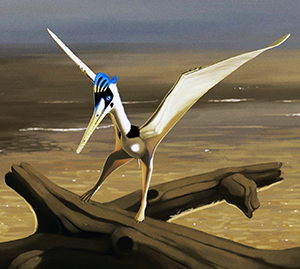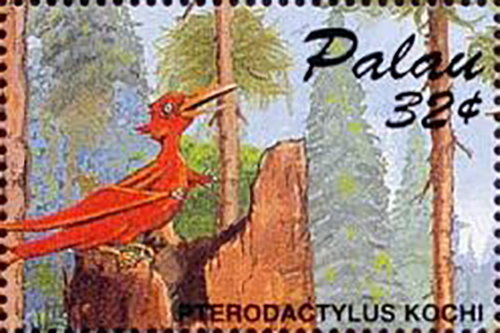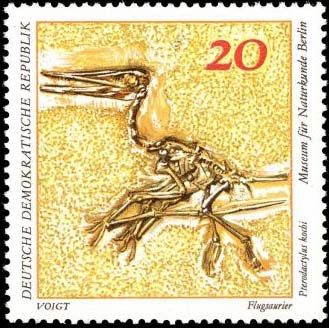Diopecephalus kochi Seeley, 1871

(Da: www.johnconway.art)
Phylum: Chordata Haeckel, 1874
Subphylum: Vertebrata Cuvier, 1812
Classe: Reptilia Laurenti, 1768
Ordine: Pterosauria Kaup, 1834
Famiglia: Pterodactylidae Meyer, 1830
Genere: Diopecephalus Seeley, 1871
Descrizione
Nel 1837, Johann Andreas Wagner nominò una nuova specie di Pterodactylus, ossia il Pterodactylus kochi, rinvenuta all'interno dei Calcari di Solnhofen, in Germania. L'esemplare originale è rappresentato da uno scheletro di un esemplare giovane articolato e quasi completo. Negli anni successivi diversi altri esemplari, soprattutto giovani, vennero attribuiti a questa specie. Nel 1871, Harry Govier Seeley nominò un nuovo genere per questa specie, il Diopecephalus, inserendo le specie Pterodactylus cristatus e Pterodactylus longicollum all'interno del genere appena creato, sebbene oggi siano gli esemplari tipo, rispettivamente, di Germanodactylus e Ardeadactylus. Il genere Diopecephalus venne nominato principalmente anche per contenere tutti gli pterosauri che possedevano una narice unita e una fenestra anterorbitale. Tuttavia, oggi questa caratteristica è presente in tutti gli pterodactyloidi dalla coda corta, e nei Wukongopteridae. Seeley non fornì un'etimologia per opecephalus, il che era una pratica comune all'epoca della sua pubblicazione. Il nome Diopecephalus, probabilmente, si traduce come "vedere attraverso la testa", derivando dalla parola greca diapao ossia vedere attraverso e kephali ossia testa. Se ciò rappresentasse la sua corretta etimologia, potrebbe essere un riferimento alla grande fenestra anterorbitale presente nel cranio dell'olotipo di Diopecephalus kochi. Il Diepecephalus è molto simile alla specie contemporanea Pterodactylus antiquus. In effetti, molti specialisti di pterosauri considerano Diopecephalus kochi come una specie del genere Pterodactylus, o come sinonimo della specie tipo Pterodactylus antiquus. La maggior parte degli esemplari che una volta si pensava appartenessero al Diopecephalus kochi si sono infine rivelati esemplari giovani di Pterodactylus, Ctenochasma, Germanodactylus e altri pterodactyloidi. Tuttavia, nel 2014 e nel 2017 Steven Vidovic e David Martill hanno riesumato il genere Diopecephalus per diversi motivi. Innanzitutto, notarono che l'olotipo e alcuni altri campioni riferiti al Diopecephalus hanno proporzioni che differiscono dal Pterodactylus. Nel Diopecephalus ci sono processi ossei più lunghi sulle sue vertebre cervicali, ossa delle mani meno robuste e un pre pube più robusto con una lama distale più ampia. In secondo luogo, quando il Pterodactylus antiquus e il Diopecephalus kochi sono stati entrambi inclusi in un'analisi filogenetica di pterosauri, Vidovic e Martill hanno scoperto che fanno in realtà parte di diversi lignaggi. Il Diopecephalus è stato collocato come il membro più basale della linea Ctenochasmatoidea, mentre il Pterodactylus viene collocato come pterodactyloide basale fuori del lignaggio compreso tra gli ctenochasmatoidi, gli ornithocheiroidi e gli azhdarchoidi. Inoltre, Vidovic e Martill hanno scoperto che le due specie di Germanodactylus non erano imparentate ai ctenochasmatoidi come in molte altre analisi filogenetiche, ma facevano invece parte del vasto lignaggio azhdarchoide, vicino ai dsungaripteridi. Tuttavia, saranno necessarie un ulteriori lavori per convalidare il Diopecephalus kochi come un vero taxon e non un sinonimo di Pterodactylus antiquus. All'epoca de Diopecephalus, circa 150 milioni di anni fa, gran parte dell'Europa era sommersa da un basso mare tropicale. Vi erano numerose isole basse e dal clima arido formando un tropicale arcipelago, popolato da numerose specie di pterosauri, così come dall'avialae Archaeopteryx. Il Diopecephalus, probabilmente, viveva e cacciava lungo le coste, alla ricerca di piccole prede.
Diffusione
Il Diopecephalus (il cui nome, probabilmente, significa "vedere attraverso la testa") è un genere estinto di pterosauro pterodactyloide vissuto nel Giurassico superiore, circa 150 milioni di anni fa (Titoniano), in quelli che oggi sono i Calcari di Solnhofen, in Baviera, Germania. Il genere contiene una singola specie, ossia il Diopecephalus kochi, originariamente descritta come una specie di Pterodactylus, sotto il nome di Pterodactylus longicollum, con longicollum erroneamente elencato come specie tipo.
Sinonimi
= Cycnorhamphus fraasii Seeley 1891 = Gallodactylus longicollum Fabre 1974 = Ornithocephalus longipes Olshevsky 1978 (Ornithocephalus è un nome obsoleto per Pterodactylus) = Ornithocephalus vulturinus Olshevsky 1978 (Ornithocephalus è un nome obsoleto per
Bibliografia
–Fischer von Waldheim, Gotthelf (1813). Zoognosia tabulis synopticis illustrata : in usum praelectionum mperalis Medico-Chirurgicae Mosquenis edita. Vol. 1. Mosquae [Moscow]: Typis Nicolai S. Vsevolozsky. p. 466.
–Gudger, E.W. (1944). "The Earliest Winged Fish-Catchers". The Scientific Monthly. 59 (2): 120-129.
–Schweigert, G. (2007). "Ammonite biostratigraphy as a tool for dating Upper Jurassic lithographic limestones from South Germany - first results and open questions" (PDF). Neues Jahrbuch für Geologie und Paläontologie, Abhandlungen. 245 (1): 117-125.
–Unwin, D. M. (2003). "On the phylogeny and evolutionary history of pterosaurs". Geological Society, London, Special Publications. 217 (1): 139-190.
–Longrich, N.R.; Martill, D.M.; Andres, B. (2018). "Late Maastrichtian pterosaurs from North Africa and mass extinction of Pterosauria at the Cretaceous-Paleogene boundary". PLOS Biology. 16 (3): e2001663.
–Osi, A.; Prondvai, E.; Géczy, B. (2010). "The history of Late Jurassic pterosaurs housed in Hungarian collections and the revision of the holotype of Pterodactylus micronyx Meyer 1856 (a 'Pester Exemplar')". Geological Society, London, Special Publications. 343 (1): 277-286.
–Unwin, David M. (2006). The Pterosaurs: From Deep Time. New York: Pi Press. p. 246.
–Brougham, Henry P. (1844). "Dialogues on instinct; with analytical view of the researches on fossil osteology". Knight's Weekly Volume for All Readers. 19.
–Collini, C A. (1784). "Sur quelques Zoolithes du Cabinet d'Histoire naturelle de S. A. S. E. Palatine & de Bavière, à Mannheim". Acta Theodoro-Palatinae Mannheim (in French). 5 Physicum: 58-103 (1 plate).
–Taquet, P.; Padian, K. (2004). "The earliest known restoration of a pterosaur and the philosophical origins of Cuvier's Ossemens Fossiles". Comptes Rendus Palevol. 3 (2): 157-175.
–Wagler, Johann Georg (1830). Natürliches System der Amphibien : mit vorangehender Classification der Säugethiere und Vögel : ein Beitrag zur vergleichenden Zoologie (in German). München.
–Cuvier, G. (1801). "Extrait d'un ouvrage sur les espèces de quadrupèdes dont on a trouvé les ossemens dans l'intérieur de la terre". Journal de Physique, de Chimie et d'Histoire Naturelle (in French). 52: 253-267.
–Cuvier, G. (1809). "Mémoire sur le squelette fossile d'un reptile volant des environs d'Aichstedt, que quelques naturalistes ont pris pour un oiseau, et dont nous formons un genre de Sauriens, sous le nom de Petro-Dactyle". Annales du Muséum national d'Histoire Naturelle, Paris. 13: 424-437.
–Cuvier, G. (1812). "Article V - Sur le squelette fossile d'un reptile volant des environs d'Aichstedt, que quelques naturalistes ont pris pour un oiseau et dont nous formons un genre de sauriens, sous le nom de ptéro-dactyle". Recherches sur les ossemens fossiles de quadrupèdes : où l'on rétablit les caractères de plusieurs espèces d'animaux que les révolutions du globe paroissent avoir détruites (in French). Vol. Tome 4. Paris: Deterville.
–Bennett, S. Christopher (2013). "New information on body size and cranial display structures of Pterodactylus antiquus, with a revision of the genus". Paläontologische Zeitschrift. 87 (2): 269-289.
–von Sömmerring, S.T. (1817). "Ueber einen Ornithocephalus brevirostris der Vorwelt". Denkschriften der Bayerischen Akademie der Wissenschaften (in German). 6: 89-104.
–Padian, K. (1987). "The case of the bat-winged pterosaur. Typological taxonomy and the influence of pictorial representation on scientific perception". In Czerkas, S. J.; Olson, E. C. (eds.). Dinosaurs past and present. Vol. 2. Los Angeles: Natural History Museum of Los Angeles County in association with University of Washington Press, Seattle and London. pp. 65-81.
–Rafinesque, C.S. (1815). Analyse de la nature, ou tableau de l'univers et des corps organisés (L'Imprimerie de Jean Barravecchia ed.). p. 224.
–Cuvier, G. (1819). "Pterodactylus longirostris". In Oken, Lorenz (ed.). Isis (oder Encyclopädische Zeitung) von Oken (in German). Jena : Expedition der Isis. pp. 1126, 1788.
–Lydekker, Richard (1888). Catalogue of Fossil Reptilia and Amphibia in the British Museum (Natural History). Part I. Containing the Orders Ornithosauria, Crocodilia, Dinosauria, Squamata, Rhynchocephalia and Pterosauria. Taylor and Francis. pp. 2-37.
–Bennett, S.C. (1996). "Year-classes of pterosaurs from the Solnhofen Limestone of Germany: Taxonomic and Systematic Implications". Journal of Vertebrate Paleontology. 16 (3): 432-444.
–Bennett, S.C. (2002). "Soft tissue preservation of the cranial crest of the pterosaur Germanodactylus from Solnhofen". Journal of Vertebrate Paleontology. 22 (1): 43-48.
–Jouve, S. (2004). "Description of the skull of a Ctenochasma (Pterosauria) from the latest Jurassic of eastern France, with a taxonomic revision of European Tithonian Pterodactyloidea". Journal of Vertebrate Paleontology. 24 (3): 542554.

|
Data: 22/04/1995
Emissione: Dinosauri Stato: Palau Nota: Emesso in un minifoglio di 18 v. diversi |
|---|

|
Data: 06/02/1973
Emissione: Museo di Storia Naturale di Berlino Stato: Germany (Est) |
|---|